中国酒文化(英文版)
- 格式:ppt
- 大小:3.07 MB
- 文档页数:24
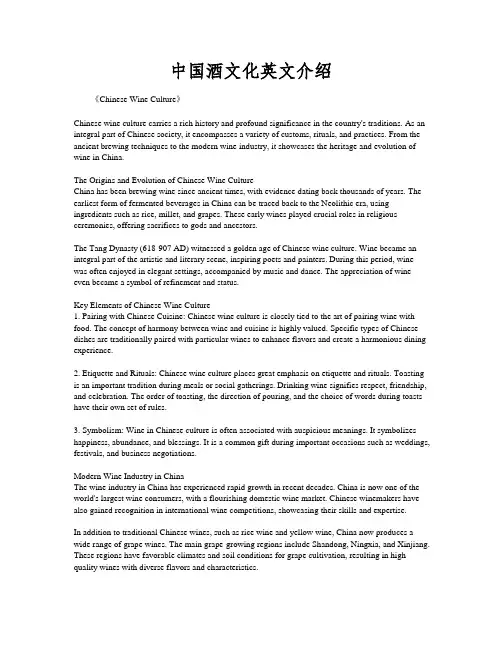
中国酒文化英文介绍《Chinese Wine Culture》Chinese wine culture carries a rich history and profound significance in the country's traditions. As an integral part of Chinese society, it encompasses a variety of customs, rituals, and practices. From the ancient brewing techniques to the modern wine industry, it showcases the heritage and evolution of wine in China.The Origins and Evolution of Chinese Wine CultureChina has been brewing wine since ancient times, with evidence dating back thousands of years. The earliest form of fermented beverages in China can be traced back to the Neolithic era, using ingredients such as rice, millet, and grapes. These early wines played crucial roles in religious ceremonies, offering sacrifices to gods and ancestors.The Tang Dynasty (618-907 AD) witnessed a golden age of Chinese wine culture. Wine became an integral part of the artistic and literary scene, inspiring poets and painters. During this period, wine was often enjoyed in elegant settings, accompanied by music and dance. The appreciation of wine even became a symbol of refinement and status.Key Elements of Chinese Wine Culture1. Pairing with Chinese Cuisine: Chinese wine culture is closely tied to the art of pairing wine with food. The concept of harmony between wine and cuisine is highly valued. Specific types of Chinese dishes are traditionally paired with particular wines to enhance flavors and create a harmonious dining experience.2. Etiquette and Rituals: Chinese wine culture places great emphasis on etiquette and rituals. Toasting is an important tradition during meals or social gatherings. Drinking wine signifies respect, friendship, and celebration. The order of toasting, the direction of pouring, and the choice of words during toasts have their own set of rules.3. Symbolism: Wine in Chinese culture is often associated with auspicious meanings. It symbolizes happiness, abundance, and blessings. It is a common gift during important occasions such as weddings, festivals, and business negotiations.Modern Wine Industry in ChinaThe wine industry in China has experienced rapid growth in recent decades. China is now one of the world's largest wine consumers, with a flourishing domestic wine market. Chinese winemakers have also gained recognition in international wine competitions, showcasing their skills and expertise.In addition to traditional Chinese wines, such as rice wine and yellow wine, China now produces a wide range of grape wines. The main grape-growing regions include Shandong, Ningxia, and Xinjiang. These regions have favorable climates and soil conditions for grape cultivation, resulting in high-quality wines with diverse flavors and characteristics.ConclusionThe book《Chinese Wine Culture》 unveils the fascinating history, customs, and rituals behind China's wine culture. From ancient rituals to modern winemaking, it invites readers to explore the rich heritage and diverse flavors of Chinese wines. With its unique traditions and profound symbolism, Chinese wine culture continues to thrive and captivate both domestic and international audiences.。
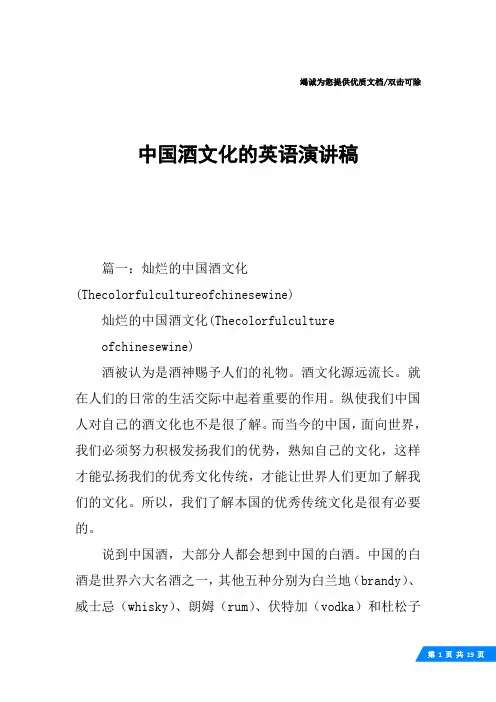
竭诚为您提供优质文档/双击可除中国酒文化的英语演讲稿篇一:灿烂的中国酒文化(Thecolorfulcultureofchinesewine)灿烂的中国酒文化(Thecolorfulcultureofchinesewine)酒被认为是酒神赐予人们的礼物。
酒文化源远流长。
就在人们的日常的生活交际中起着重要的作用。
纵使我们中国人对自己的酒文化也不是很了解。
而当今的中国,面向世界,我们必须努力积极发扬我们的优势,熟知自己的文化,这样才能弘扬我们的优秀文化传统,才能让世界人们更加了解我们的文化。
所以,我们了解本国的优秀传统文化是很有必要的。
说到中国酒,大部分人都会想到中国的白酒。
中国的白酒是世界六大名酒之一,其他五种分别为白兰地(brandy)、威士忌(whisky)、朗姆(rum)、伏特加(vodka)和杜松子酒(gin)。
外国友人在第一次品尝中国酒的时候都会很谨慎。
然而,只要他们尝过一两次,就会爱上各式的酒,并且开始享受饮酒的乐趣。
1、关于中国酒起源的传说(TheFairyTaleoftheoriginofchinesewine)我们的祖先放弃了她们的游牧生活,选择在黄河流域群居的时候,种植了多种多样的谷物,这为日后酿造美酒奠定了基础。
据说中国的酿酒技术始于夏朝。
仪狄和杜康,被认为是中国造酒业的鼻祖。
据史料记载,仪狄应君主禹的要求,付出了巨大的努力,终于成功地用发酵的糯米酿造出了芳醇的美酒。
生活在夏朝的杜康,凭借用高粱酿造出的美酒,而受到赞誉。
据史料记栽,冬日里的一天,杜康将一些煮过的高粱米放到了树洞里。
第二年春天,从这个树洞里散发出浓浓的香味,扑鼻而入。
之后,杜康发现正是发酵的高粱米散发出诱人的香气。
这个偶然的发现给了他用发酵的高粱米酿酒的灵感。
2、中国的国酒(ThenationalLiquor)——茅台(maotai)在重大历史事件中,如日内瓦会谈、中美建交,茅台酒都是打破历史坚冰的特殊利器。
党和国家领导人多次将茅台作为“国家级礼品”赠送给外国领导人。
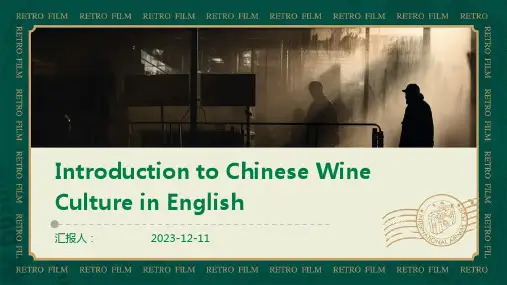
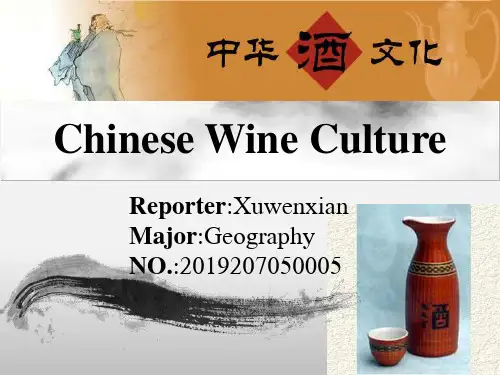
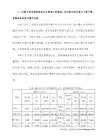
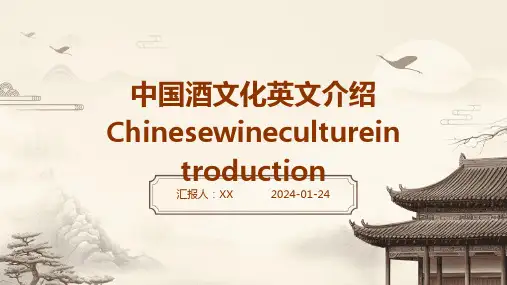
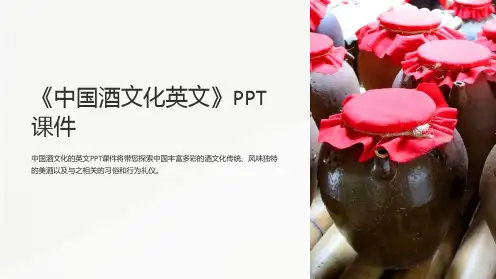
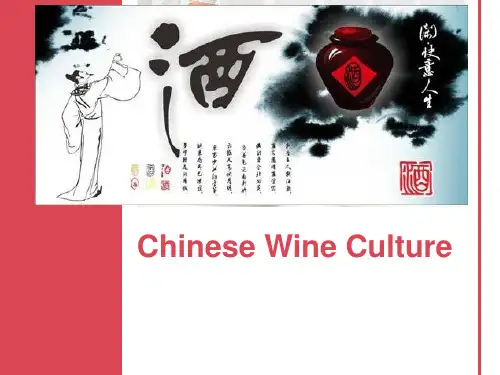
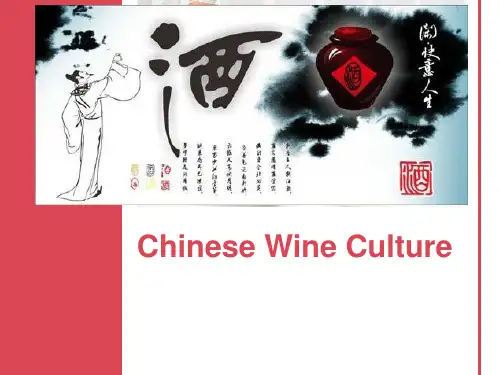
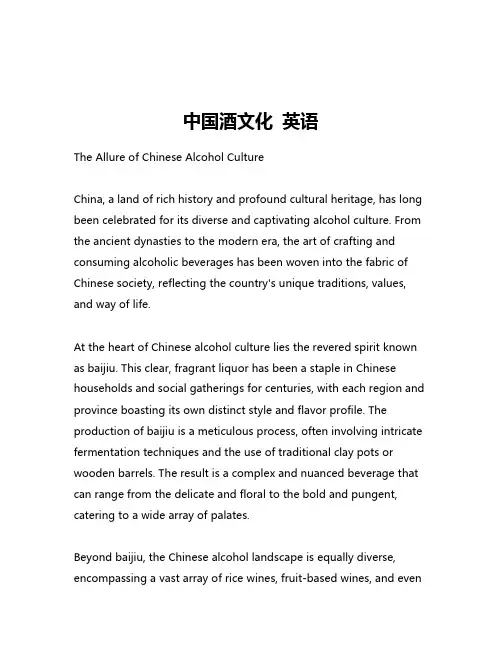
中国酒文化英语The Allure of Chinese Alcohol CultureChina, a land of rich history and profound cultural heritage, has long been celebrated for its diverse and captivating alcohol culture. From the ancient dynasties to the modern era, the art of crafting and consuming alcoholic beverages has been woven into the fabric of Chinese society, reflecting the country's unique traditions, values, and way of life.At the heart of Chinese alcohol culture lies the revered spirit known as baijiu. This clear, fragrant liquor has been a staple in Chinese households and social gatherings for centuries, with each region and province boasting its own distinct style and flavor profile. The production of baijiu is a meticulous process, often involving intricate fermentation techniques and the use of traditional clay pots or wooden barrels. The result is a complex and nuanced beverage that can range from the delicate and floral to the bold and pungent, catering to a wide array of palates.Beyond baijiu, the Chinese alcohol landscape is equally diverse, encompassing a vast array of rice wines, fruit-based wines, and evenbeer. Each of these beverages holds its own significance and cultural significance. Rice wines, for instance, have been revered for their medicinal properties and are often used in traditional Chinese medicine. Meanwhile, the production of fruit-based wines, such as those made from grapes, plums, or even lychees, reflects the country's agricultural diversity and the ingenuity of its people.The consumption of alcohol in China is not merely a means of indulgence but a deeply rooted social ritual. Sharing a glass of baijiu or rice wine is often a symbol of camaraderie, respect, and the forging of meaningful connections. In traditional Chinese banquets and celebrations, the pouring and sharing of alcohol is a ceremonial act, with specific etiquette and customs that have been passed down through generations.The significance of alcohol in Chinese culture extends beyond the realms of taste and tradition. It is also deeply intertwined with the country's rich artistic heritage. The appreciation of fine baijiu or wine has long been celebrated in Chinese poetry, literature, and visual arts. Calligraphic labels adorning bottles of premium liquor are not merely decorative but often convey profound messages or historical references.Furthermore, the production of Chinese alcoholic beverages has evolved alongside the country's technological advancements. Whilehonoring traditional methods, modern distilleries and wineries have embraced innovative techniques and equipment to enhance the quality and consistency of their products. This fusion of ancient wisdom and modern innovation has contributed to the growing global recognition and appreciation of Chinese alcohol culture.As China continues to assert its presence on the world stage, its alcohol culture has also gained increasing international attention. Baijiu, in particular, has been making strides in the global market, with more and more consumers outside of China discovering the unique flavors and complexities of this centuries-old spirit. This cultural exchange has not only broadened the horizons of international drinkers but also fostered a deeper understanding and appreciation of Chinese traditions.In conclusion, the alcohol culture of China is a multifaceted and captivating aspect of the country's rich heritage. From the intricate production processes to the deeply rooted social rituals, the allure of Chinese alcohol transcends the mere act of consumption. It is a testament to the ingenuity, creativity, and enduring legacy of the Chinese people, a cultural tapestry that continues to captivate and inspire people around the world.。
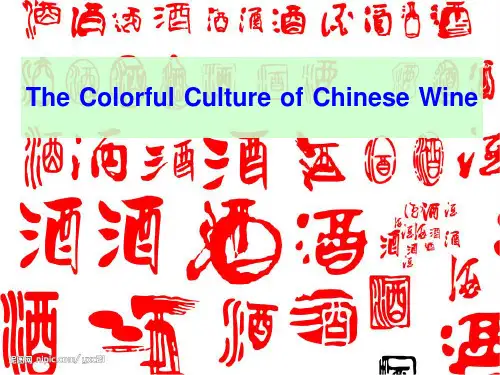
酒文化英语演讲稿篇一:中国酒文化 Chinese Wine Culture1、中国酒文化 Chinese Wine Culture中国人在7000年以前就开始用谷物酿酒。
总的来说,不管是古代还是现代,酒都和中国文化息息相关。
长久以来,中国的酒文化在人们生活中一直扮演着重要的角色。
我们的祖先在写诗时以酒助兴,在宴会中和亲朋好友敬酒。
作为一种文化形式,酒文化也是普通百姓生活中不可分割的部分,比如生日宴会、送别晚宴、婚礼庆典等。
Chinese people began to make spirits with grains seven thousand years ago. Generally speaking,wine has a close connection with culture in China in both ancient and modern times. Chinese wine culture has been playing a quite important role in Chinese people's life for a long time. Our Chinese ancestors used wine to enjoy themselves while writing poetry, or to make a toast to their relatives and friends during a feast. Wine culture, as a kind of culture form, is also an inseparable part in the life of ordinary Chinese people such as birthday party, farewell dinner, wedding, etc.2、中国书法Chinese Calligraphy中国书法历史悠久,它不仅是汉字的传统书写形式,也是体现自我修养和自我表达的艺术。
中国酒文化英文作文英文:As a Chinese person, I am very proud of our country's rich and diverse culture, including our unique wine culture. China has a long history of wine production, dating back to the Shang Dynasty over 3,000 years ago. Today, Chinese wine has become increasingly popular both domestically and internationally.One of the most famous types of Chinese wine is baijiu, a strong distilled spirit made from grain. It is often consumed during important events and celebrations, such as weddings and business banquets. Another popular type of Chinese wine is huangjiu, a traditional fermented rice wine that is often served warm. It is commonly enjoyed withmeals and is said to have health benefits.In addition to these traditional wines, China has also been producing more Western-style wines in recent years.Regions such as Ningxia and Shandong have become known for their high-quality wines, winning awards at international competitions.Overall, China's wine culture is an important part of our heritage and continues to evolve and grow. It is a reflection of our country's rich history and diverseculinary traditions.中文:作为一位中国人,我为我们国家丰富多彩的文化感到自豪,其中包括我们独特的酒文化。
中国酒文化的英文作文"English:"China boasts a rich and diverse culture, and its tradition of alcohol consumption is deeply embedded in its history. Chinese alcohol culture encompasses a wide range of beverages, including baijiu, huangjiu, and various types of rice wine, each with its own unique flavor profile and brewing techniques.One of the most iconic aspects of Chinese alcohol culture is baijiu, a strong distilled spirit typically made from sorghum or other grains. Baijiu is often enjoyed during celebratory occasions, such as weddings and business banquets, where toasts are exchanged as a sign of respect and camaraderie. The saying "ganbei," meaning "bottoms up," is commonly heard during these festivities, encouraging everyone to empty their glasses in unison.Another prominent feature of Chinese alcohol culture isthe concept of "g ānx ì," which translates to "building relationships through drinking." In Chinese business culture, it's not uncommon for deals to be brokered over glasses of baijiu, as sharing a drink is seen as a way to foster trust and strengthen bonds between colleagues and clients. Refusing a drink can sometimes be considered impolite or even disrespectful, as it may be interpreted as rejecting the opportunity to connect on a personal level.Aside from baijiu, huangjiu, or yellow rice wine, holds a special place in Chinese culinary traditions. This sweet, fermented beverage is often used in cooking to enhance the flavors of various dishes, particularly in dishes from the Jiangnan region, such as drunken chicken or fish. Additionally, huangjiu is enjoyed on its own, eitherchilled or warmed, depending on the season and personal preference.Furthermore, Chinese alcohol culture extends beyondjust the beverages themselves to the vessels in which they are served. Ornate cups and decanters are often used during formal occasions, adding a touch of elegance to thedrinking experience. Conversely, simple ceramic or glass cups are more common for casual gatherings among friends and family, where the focus is more on enjoying eachother's company than on the presentation of the alcohol.In summary, Chinese alcohol culture is deeply rooted in tradition and plays a significant role in social interactions and celebrations. Whether it's raising a glass of baijiu to toast a special occasion or sharing a bottle of huangjiu over a meal, alcohol serves as a symbol of camaraderie and hospitality in Chinese society."中文,"中国拥有丰富多彩的文化,其酒文化传统深深扎根于其历史之中。
酒文化英语演讲稿篇一:中国酒文化 Chinese Wine Culture1、中国酒文化 Chinese Wine Culture中国人在7000年以前就开始用谷物酿酒。
总的来说,不管是古代还是现代,酒都和中国文化息息相关。
长久以来,中国的酒文化在人们生活中一直扮演着重要的角色。
我们的祖先在写诗时以酒助兴,在宴会中和亲朋好友敬酒。
作为一种文化形式,酒文化也是普通百姓生活中不可分割的部分,比如生日宴会、送别晚宴、婚礼庆典等。
Chinese people began to make spirits with grains seven thousand years ago. Generally speaking,wine has a close connection with culture in China in both ancient and modern times. Chinese wine culture has been playing a quite important role in Chinese people's life for a long time. Our Chinese ancestors used wine to enjoy themselves while writing poetry, or to make a toast to their relatives and friends during a feast. Wine culture, as a kind of culture form, is also an inseparable part in the life of ordinary Chinese people such as birthday party, farewell dinner, wedding, etc.2、中国书法Chinese Calligraphy中国书法历史悠久,它不仅是汉字的传统书写形式,也是体现自我修养和自我表达的艺术。
关于中国酒文化的英语作文(中英文实用版)Title: The Culture of Chinese LiquorThe culture of Chinese liquor, deeply rooted in the nation"s history, is an integral part of China"s rich cultural heritage.It reflects the social etiquette, artistic expression, and philosophical thoughts of the Chinese people over thousands of years.Chinese liquor, often referred to as "Baijiu," is diverse in its forms, flavors, and production methods.It is made from various ingredients such as grain, including rice, wheat, and sorghum.The fermentation and distillation processes are meticulous and time-consuming, reflecting the craftsmanship and dedication of Chinese brewers.The consumption of Baijiu is not just about imbibing alcohol; it is a significant part of social interactions and ceremonies.In China, offering a toast is a way to show respect, build relationships, and foster goodwill.During formal dinners, guests are expected to participate in the toast, which involves a series of rituals.For instance, when toasting to elders or superiors, one should hold their glass lower than the other person"s as a sign of respect.Moreover, Chinese literature and art are filled with references to liquor.Poets like Li Bai and Du Fu often mentioned the pleasures and pains of drinking in their works.The famous Chinese painting "Drunken Beauty"by Gu Kaizhi illustrates the elegant and carefree demeanor of a woman in a state of tipsiness.Chinese liquor is also closely tied to traditional festivals.During the Spring Festival, it is customary to drink Baijiu as a way to celebrate the coming of a new year and wish for good fortune.In the Mid-Autumn Festival, drinking moonshine while appreciating the full moon is a cherished tradition.In recent years, the Chinese liquor industry has seen a revival, with many distilleries adopting traditional methods while embracing modern technology.The government has also recognized the importance of protecting and promoting the cultural heritage of Chinese liquor, naming certain brands as intangible cultural heritage.In conclusion, the culture of Chinese liquor is a multifaceted reflection of China"s historical, social, and artistic identity.It is not merely a drink but a symbol of the nation"s traditions and values.---标题:中国酒文化中国酒文化,根植于国家的历史之中,是中国丰富文化遗产的重要组成部分。